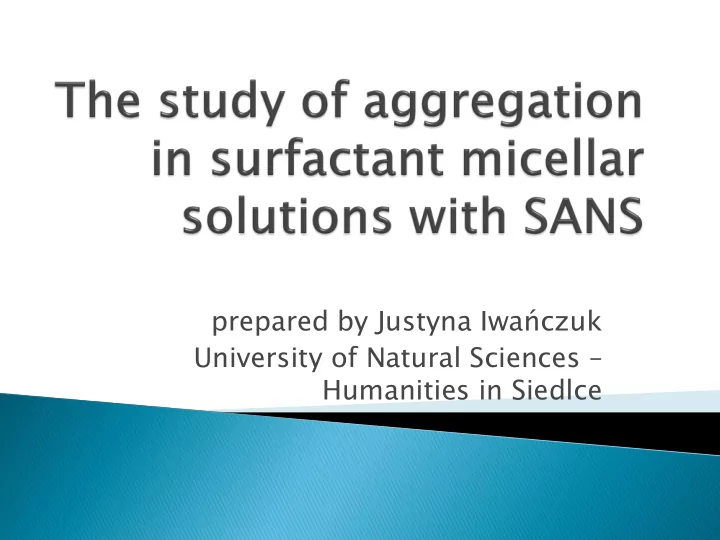

prepared by Justyna Iwańczuk University of Natural Sciences – Humanities in Siedlce
Supervisor of the project: Aldona Rajewska, PhD
Surfactants (Surface active agent) are compounds that are amphiphilic, meaning they contain both hydrophobic groups (their tails) and hydrophilic groups
Example
The concentration at which surfactants start forming micelles is called the "critical al micelle le concentra centration tion (CMC)" )". Kraft t point is the minimum temperature at which surfactants form micelles. The Krafft temperature is a point of phase change below which the surfactant remains in crystalline form, even in aqueous solution. Micellization
1 – two reflectors; 2 – zone of reactor with moderator; 3 – chopper; 4 – first collimator; 5 – vacuum tube; 6 – second collimator; 7 – thermostate; 8 – samples table; 9 – goniometer; 10-11 – Vn-standard; 12 – ring-wire detector; 13 – position-sensitve edetector "Volga"; 14 – direct beam detector.
Why Why use neutrons rons? -Neutrons interact through short-range nuclear interactions. They have no charge and are very penetrating and do not destroy samples. - Neutron wavelengths are comparable to atomic sizes and interdistance spacings In this technique radiation is elastically scattered by a sample and the resulting scattering pattern is analysed to provide information about the size, shape and orientation of some component of the sample. SANS are used in situations where the important physical aspects ( size, range of interaction etc.) occur at distances extanding typically from 10 to 1000 Å
Monodisperse, homogeneous, globular particles, the total scattering intensity can be expressed by this equation I(q)=NS(q)P(q) Where N- number of parcitles S(q)- structure factor P(q)-form factor
In experiment determined the temperature and concentration influence on the micelle shape of two nonionic surfactants: Pentaethylene glycol monododecyl ether ( C 12 E 5 ) , CMC=7*10 -5 M at 25 o C Octaethylene glycol monododecyl ether (C 12 E 8 ), CMC= 8*10 -5 M at 25 o C
nonionic classic surfactant c=1% o C 10 o C 15 o C 20 o C 25 1 o C 30 -1 o C 35 d (Q)/d , cm 0.1 0.01 0.1 -1 ] Q[A Fig.1. Intensity of neutron scattering vs scattering vector for concentration c 1 =1% at temperatures: 10 o , 15 o , 20 o , 25 o , 30 o and 35 o C.
0.08 c=1% o C 10 o C 15 o C 20 0.06 o C 25 o C 30 o C 35 0.04 p(r) 0.02 0 1 2 3 4 5 6 7 8 9 10 r [nm] Fig. 2. Pair distance distributon function (PDDF) for the … (c=0,17%) system from SANS measurements for temperatures 10, 15, 20, 25 30 and 35 Celsius degree
100 nonionic classic surfactant 10 o C 6 o C 10 1 o C 15 -1 o C 20 d (Q)/d , cm o C 25 0.1 o C 30 o C 35 0.01 1E-3 1E-4 0.01 0.1 -1 ] Q [A Fig. 3 Intensity of neutron scattering vs scattering vector for concentration c 1 =1% at temperatures: 10 o , 15 o , 20 o , 25 o , 30 o and 35 o C
Fig. 4 Pair distance distributon function (PDDF) for the C17 (c=1 %) system from SANS measurements for temperature 6 Celsius degree
Fig. 5 Pair distance distributon function (PDDF) for the C17 (c=1 %) system from SANS measurements for temperature 15 Celsius degree
If intensity of neutrons scattering increases the number of micelles grow up in micellar solution For the bigger concentrations and temperatures the maximum have a higher value If the curve p(r) is symmetric – micelles have spherical shape If the curve p(r) is asymmetric – micelles have cylindrical shape Distance between zero point and point where curve p(r) cross axis r is equal to diameter of micelle
,,Small Angle Neutron Scattering ” Stephen M.King ISIS Facility, Rutheford Appleton Laboratory, December 1995 Otto Glater and others Langmuire, 2000, 16, 8692- 8701 „ Nonionic Micelles near the Critical Point; Micellas Growth and Attractive Interaction ” ,,Analysis of SANS and USANS Data” ,Steve Kline, NCNR Summer School, June 26-30, 2006 A.Guiner, G. Fournet „ Small- Angle Scattering of X- rays ”, John Wiley, 1955 ,,Surfactants: Fundamentals and Applications in the Petroleum Industry” Laurier L. Shramm, Petroleum Recovery Institute, 2000
Recommend
More recommend